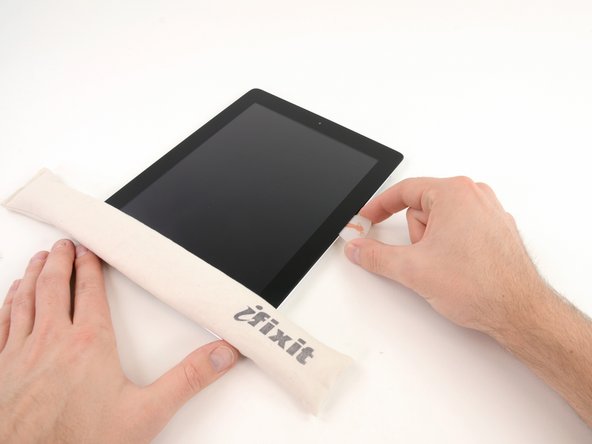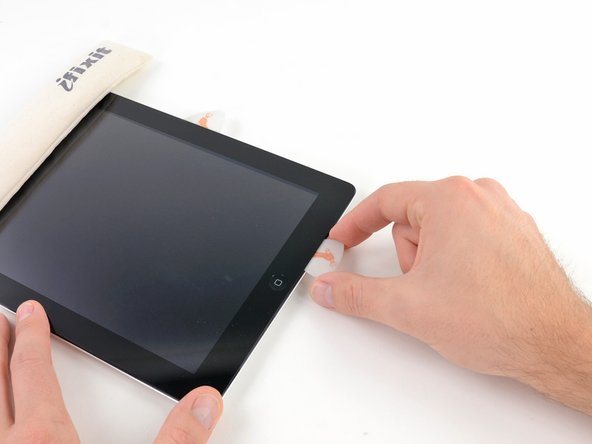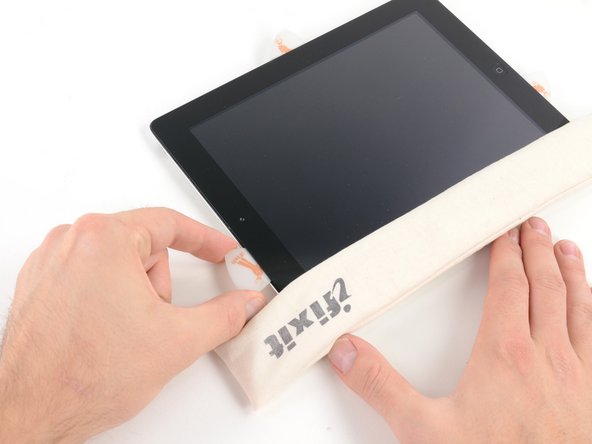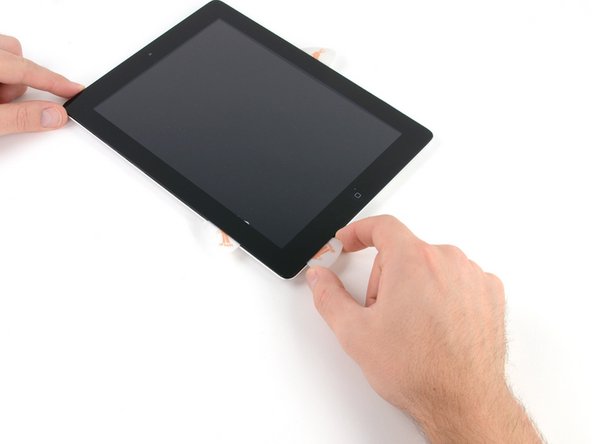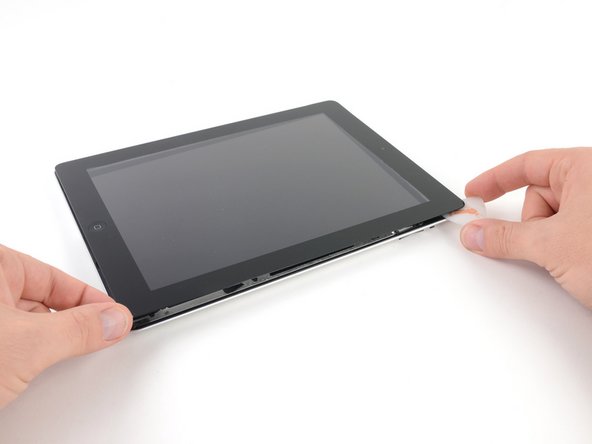iPad 2 GSM Home Button Control Board Replacement
Duration: 45 minutes
Steps: 35 Steps
Get ready to tackle the replacement of your electronic home button switch! Just a heads up, some of the images in this guide feature a Wi-Fi model, so the insides might look a tad different from your cellular model. But don’t worry, the process is pretty much the same for both models, with a few exceptions noted along the way. Let’s dive in and get your device back in action!
Step 1
For carousel microwaves: Ensure the plate can spin without any hiccups. If your iOpener gets jammed, it might heat up and cause some trouble.
It's a good idea to give your microwave a quick clean before you start—no one wants leftover gunk sticking to the iOpener and ruining the vibe.
- Pop the iOpener right in the middle of your microwave to get things heating up!
Tools Used
Step 2
Don’t let the iOpener get too toasty—overheating it might cause it to pop like a balloon! Keep it below 100˚C (212˚F).
If the iOpener looks puffed up or swollen, give it a pass and don’t touch it.
If the iOpener is still too hot in the center to handle, keep using it gently while it cools down a bit before reheating. When heated just right, it should stay warm for about 10 minutes.
Microwave times can vary depending on your model's wattage. Your iOpener is ready when it's just a tad too warm to comfortably hold—perfectly heated for action!
- Give your iOpener a quick 30-second heat-up in the microwave.
- As you continue, keep an eye on your iOpener—when it starts to cool down, pop it back in the microwave for another 30 seconds to keep things toasty.
Tools Used
Step 3
Heads up! The iOpener will be seriously hot, so handle with care. Grab an oven mitt if you want to keep your fingers happy.
- Carefully take the iOpener out of the microwave, grabbing it by one of the two flat ends so you don’t accidentally touch the hot middle part.
Tools Used
Step 4
Careful now! The iOpener can get pretty toasty, so make sure to grab it only by those handy end tabs.
No microwave? No problem! Just heat your iOpener by placing it in some boiling water instead.
- Grab a pot or pan and fill it with enough water to make sure your iOpener can take a nice dip.
- Turn up the heat and bring that water to a lively boil. Then, go ahead and switch off the heat.
- Carefully drop your iOpener into the hot water for about 2-3 minutes. Just make sure it's having a good swim and is completely submerged.
- Use some tongs to fish out the heated iOpener from the water. Safety first!
- Give the iOpener a good towel dry. We want it to be nice and cozy.
- And there you have it! Your iOpener is all set for action! If it needs another warm-up, just repeat the water heating process and give it another 2-3 minute soak.
Tools Used
Step 5
Put on those safety glasses to keep your peepers safe, and watch out for that delicate LCD screen—let's keep it in one piece!
This helps keep those sneaky glass shards in check and gives the display some solid support while you pry and lift it up.
- If your display glass is cracked, keep those shards in check and protect yourself by taping over the glass before you dive in.
- Cover the iPad's screen with overlapping strips of clear packing tape until the entire front is wrapped up snugly.
- Follow the rest of the guide as best you can. Just a heads-up: once the glass is broken, it might keep cracking as you work, so be ready to carefully use a metal prying tool to lift the glass pieces out.
Step 6
Just a friendly reminder: as you dive into this repair and might be handling some tricky broken glass, we highly suggest rocking a pair of safety glasses. They’ll keep your peepers safe from any surprise glass confetti!
- Place the iOpener flat along the right edge of your iPad, pressing it down so it makes solid contact with the surface.
- Let it chill there for about 90 seconds to warm things up before you try opening the front panel.
Tools Used
Step 7
Getting the wedged tip of your trusty opening tool in between the glass and plastic might take a bit of muscle. But don’t sweat it! Just take your time and gently wiggle that plastic tool back and forth as needed. You've got this!
- Look closely! There's a tiny little gap in the iPad's adhesive ring at the upper right corner, about 2.0 inches (~5 cm) down from the top. Time to take advantage of this sneaky spot!
- Get your tool ready! Line it up with the mute button, and gently slip the tip of a plastic opening tool into that gap between the front glass and the plastic bezel. Just slide in the very tip—enough to give that crack a little nudge.
Step 8
- Carefully slip the tool right where it belongs—between the plastic display bezel and the front panel glass—to keep things smooth and damage-free.
Step 9
- Keep the tip of your plastic opening tool gently wedged between the front glass and the plastic bezel, then slide a plastic opening pick into the gap right next to it. Easy does it!
Step 10
- Take that plastic opening tool out of the iPad's grip, and gently slide the opening pick further beneath the front glass until it reaches about 0.5 inches deep. You've got this!
Step 11
- As you tackle the adhesive on the right side of the iPad, give the iOpener another round in the heat, then place it back on the bottom edge of the iPad. You've got this!
Tools Used
Step 12
This adhesive is tough, so you might need to put in a little muscle. Take it slow and steady!
If you can spot the tip of the opening pick peeking out from under the front glass, give it a gentle pull. While it's safe to use the pick at this depth, just a heads up—it might leave a bit of adhesive residue on the LCD. No biggie, though!
- As the iOpener warms up the bottom edge, start loosening the adhesive along the right side of the iPad.
- Gently slide the opening pick down the edge, carefully freeing the adhesive bit by bit.
Tools Used
Step 13
You might need to slide that warm iOpener back onto the right edge of your iPad while you peel off the adhesive. This will depend on how long your iPad has been cooling down while you were busy working your magic.
- If the opening pick is feeling a bit stubborn in the adhesive, try 'rolling' it gently along the side of the iPad to help release that sticky stuff. Take it slow, you’ve got this!
Tools Used
Step 14
- Before you pull out that first opening pick from the bottom corner of the iPad, slide a second pick under the right edge of the front glass. This will stop the adhesive from sticking again and give you a little breathing room.
- Heat up the iOpener again, then move it to the top edge of the iPad. It’ll help loosen things up for the next step.
Tools Used
Step 15
The Wi-Fi antenna is snugly secured to the bottom right corner of the iPad's rear case with screws and a cable. Since the antenna's position is a bit tricky, it's important to handle it carefully to avoid any damage. Take your time with this step, and you'll be good to go!
- Heads up: the next steps need you to be super careful.
- You'll be peeling off the adhesive that sticks the antenna to the front panel, but watch out—there are some delicate connections to the bottom of the iPad that need to stay safe. Take it slow and follow along closely.
Step 16
Keep the pick away from the bottom right corner to avoid messing with the Wi-Fi antenna. A little caution goes a long way!
- Gently slide the opening pick around the bottom right corner of the iPad to loosen the adhesive hanging out there.
Step 17
- Gently slide the tip of your opening pick along the bottom edge of the iPad to carefully loosen the adhesive holding down the Wi-Fi antenna. Keep it smooth and steady!
Be careful when moving the opening pick along the bottom right edge of the front panel. The Wi-Fi antenna is just a hair away from the corner, and if the adhesive isn't released just right, it can easily get damaged. Take your time!
Don't yank the pick all the way out from under the front glass—just ease it out enough so that about 1/8" (3 mm) of the tip is still resting underneath. It's all about that perfect balance—keep it steady and gentle!
Step 18
- Alright, now that you've passed the Wi-Fi antenna (about 3" or 75 mm from the right edge, or right next to the home button), slide that opening pick back in fully!
- Gently slide the pick to the right, freeing up the adhesive holding the Wi-Fi antenna to the front glass. Almost there!
- The antenna's held in place by screws and a cable at the bottom of the iPad. By detaching it here, you're making sure the antenna stays safe when you remove the front panel. No damage, no problem.
Step 19
Keep the iOpener's heat sessions short and sweet—just a minute at a time! And don’t forget to give it a cool-down period of at least two minutes before you heat it up again. Your iOpener will thank you for the extra care!
If the adhesive has cooled too much along the bottom edge, give your iOpener a quick reheat to warm up the adhesive where you're working. A little heat goes a long way!
- Keep sliding that opening pick under the bottom edge of the iPad, carefully navigating around the home button. Once you’re past it, tuck the pick back in about half an inch (10 mm) to keep the adhesive release going smoothly.
Tools Used
Step 20
When working on iPad 4 models, slide your pick in no deeper than 1/2 inch (10 mm) here to keep that home button ribbon cable safe and sound.
- Keep sliding that adhesive remover tool smoothly along the entire bottom edge of your iPad.
- Pop the opening pick in place right under the front glass near the home button, and leave it there to hold your progress.
Step 21
- Pop the iOpener back in the microwave to warm it up, then place it on the left edge of the iPad to gently heat and loosen the adhesive in that spot.
Tools Used
Step 22
If your adhesive has gotten a bit too cool, just swap the iOpener along the top edge and keep on trucking! And if that iOpener seems to have lost its warmth, give it another heat-up. You're doing great!
- Gently glide that opening pick along the top edge of your iPad, giving it a little tug to navigate around the front-facing camera bracket.
- This area has some seriously strong adhesive, so you might need to put in a bit of elbow grease. Take your time and be careful—let's avoid any slips that could lead to a mishap with your iPad!
- If your opening pick is feeling a bit stuck in the sticky stuff, try 'rolling' the pick just like we showed in step 9.
Tools Used
Step 23
Once your iOpener is nice and toasty, feel free to take it off the iPad for easier maneuvering. But if that adhesive is still giving you a run for your money, just pop the iOpener back in the microwave and set it on the left edge while you dive into your work.
- Keep peeling back the adhesive along the top edge of the iPad, then slide your opening pick smoothly around the top left corner. You’re doing great!
Tools Used
Step 24
The digitizer cable hangs out about 2" (50 mm) up from the iPad’s bottom edge. When your pick reaches around 2.25" (60 mm) from the bottom, it’s time to pause and take a breath.
- Gently slide the opening pick along the left side of the iPad, easing through the adhesive as you move. The glue here is pretty thin because of the digitizer running along the whole left edge. Keep the pick shallow—no more than about 10 mm (half an inch)—to avoid giving the digitizer an unwanted poke.
Step 25
Be super careful as you work! The digitizer cable is hanging out just an inch (25 mm) from the bottom of your iPad. Take it slow and steady—let's avoid any accidental snips!
- Keep that opening pick tucked under the bottom edge of the iPad and gently work it to loosen the adhesive at the bottom left corner.
Step 26
It’s possible that some of the adhesive around the iPad's edges has decided to stick around a bit longer than expected. If you find this to be the case, gently slide a pick under the edge of the iPad where the front glass is being stubborn and give that adhesive a little 'snip' to free it up.
- Grab one of those handy opening picks and gently pop up the bottom right corner of your iPad, then hold it with your fingers like a pro.
Step 27
Watch out for any sticky stuff still hanging around! Grab an opening pick and gently slice through any adhesive that might be keeping the front panel snug as a bug.
- Grab the iPad by the top and bottom right corners and gently swivel the front glass away from the device.
- When putting it back together, give the LCD a good once-over with a microfiber cloth and some compressed air to banish any dust or fingerprints before snapping the glass back on.
Step 28
- Unscrew the four 2.0 mm Phillips screws holding the LCD onto the back case—easy does it!
Step 29
- Gently raise the LCD from the edge nearest the volume buttons and swing it out from the rear case like a pro.
- Carefully place the LCD on the front panel just like you see in the second picture.
Step 30
Make sure you're gently lifting those hinged retaining flaps, not the sockets themselves. You've got this!
Check out the red highlights in the second picture to spot those sneaky retaining flaps holding things in place.
- Gently slide the edge of a plastic opening tool under the retaining flaps on the two digitizer ribbon cable ZIF sockets and flip them up with care.
Step 31
- Gently slide the edge of a plastic opening tool under the digitizer cable and carefully lift it away from the logic board shields.
- Take your time to slowly peel the digitizer cable off the sticky adhesive that’s holding it in place along the rear case.
Step 32
- Gently wiggle and pull the digitizer ribbon cable straight out of its two cozy sockets on the logic board. You've got this!
Step 33
Take it easy when handling the LCD—no need to rush. Don't try to fully detach it from the iPad; the cable will stay attached even as you gently rotate it. Just a heads-up to keep everything safe and sound!
To get that front panel assembly off, you'll need to gently slide the ribbon cable out from between the case and the LCD. Just give the LCD a little nudge to create some extra space for it to wiggle free.
- Grab the LCD by its long edge that's farthest from the digitizer cable and gently flip it back toward the rear case—like closing a book.
- While holding the LCD up, carefully slide the front panel away from the iPad. Watch out so you don’t snag the digitizer cable on the rear case or LCD.
- Place the LCD back into the body to keep it safe while you work.
Step 34
- Unscrew the two 2.1 mm Phillips #00 screws that are keeping the home button control board snugly attached to the home button assembly. You've got this!
Step 35
- Grab your trusty spudger and gently nudge the home button control board off its cozy little mounts on the front panel.
- Carefully lift and detach the home button control board from the front panel assembly like you're unwrapping a surprise gift!
























